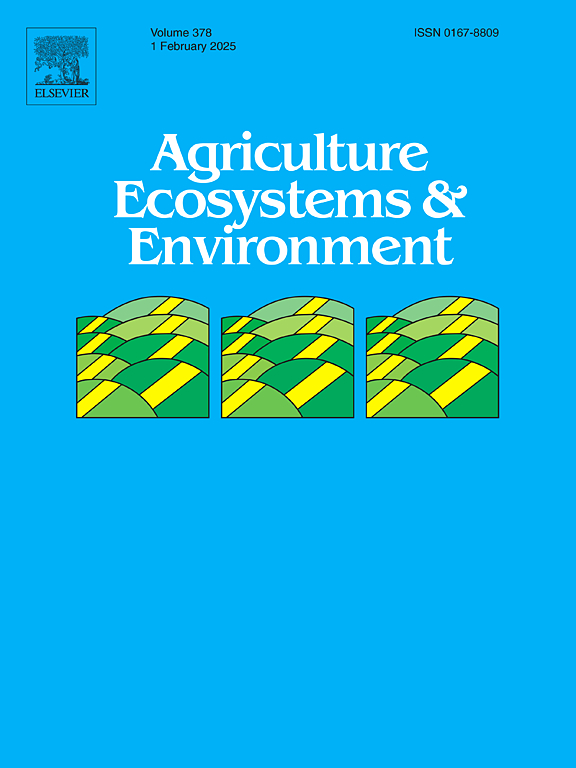Wildlife response to land-use change forces encounters between zoonotic disease hosts and farms in agricultural landscapes
IF 6
1区 农林科学
Q1 AGRICULTURE, MULTIDISCIPLINARY
引用次数: 0
Abstract
- 1.Land-use change can significantly alter wildlife movement patterns and behaviour which may increase the risk of zoonotic disease transmission, particularly diseases with wildlife maintenance hosts that intersect regularly with farmland such as bovine tuberculosis (bTB).
- 2.This study utilized an agent-based model (ABM) with high-resolution input data to simulate badger responses to clearfell forestry across 100 sites in Ireland. The model environment was constructed from multiple GIS datasets, including sett locations, habitat, farm boundaries, and forestry operations. Animal movement and behaviour in the model were parameterised using detailed analysis of GPS tracking data from over 200 collared badgers in the wild.
- 3.Our results show that badger density and herd type were the strongest predictors of alien encounters—instances where badgers move beyond their established territories and enter farms outside their usual home range. These encounters, if used as a proxy for bTB transmission risk, represent opportunities for badgers to interact with livestock, particularly cattle, increasing the likelihood of disease spread. Dairy herds, despite being fewer in number compared to beef and suckler enterprises, had a higher risk of alien encounters. Larger clearfell events significantly increased alien encounters, supporting the hypothesis that landscape disturbances elevate disease risk.
- 4.Contrary to expectations, badger dispersal distance did not significantly affect encounter rates. Instead, landscape heterogeneity, including clearfell size and farm density, played a more substantial role in modulating encounters.
- 5.Validation of the ABM using empirical bTB breakdown data confirmed a positive correlation between simulated badger encounter rates per study site and real world bTB outbreaks within those sites.
- 6.This research provides a novel spatial framework for predicting bTB risk in disturbed landscapes, offering a valuable tool for Ireland's efforts to mitigate wildlife-livestock disease transmission. By integrating high-resolution GIS data and GPS-tracked wildlife movements, this approach enhances the accuracy of agent-based models (ABMs) for applied ecology and wildlife conflict research.
野生动物对土地利用变化的反应迫使农业景观中人畜共患疾病宿主与农场之间的相遇
1.土地利用变化可以显著改变野生动物的运动模式和行为,这可能增加人畜共患疾病传播的风险,特别是与农田经常相交的野生动物维持宿主的疾病,如牛结核病。本研究利用基于主体的模型(ABM)和高分辨率输入数据来模拟獾对爱尔兰100个地点砍伐森林的反应。模型环境是由多个GIS数据集构建的,包括集合位置、栖息地、农场边界和林业作业。模型中的动物运动和行为是通过对野外200多只戴项圈的獾的GPS跟踪数据的详细分析来参数化的。我们的研究结果表明,獾的密度和种群类型是最能预测外来遭遇的因素,即獾会越过它们的既定领地,进入它们通常活动范围以外的农场。如果将这些接触作为结核分枝杆菌传播风险的代表,就意味着獾有机会与牲畜,特别是牛相互作用,从而增加了疾病传播的可能性。尽管与牛肉和乳牛企业相比,奶牛群的数量较少,但遭遇外星人的风险更高。较大的清除事件显著增加了与外星人的接触,支持了景观干扰会增加疾病风险的假设。与预期相反,獾的分散距离对遭遇率没有显著影响。相反,景观异质性,包括砍伐面积和农场密度,在调节相遇中发挥了更重要的作用。利用经验bTB分解数据对ABM进行验证,证实了每个研究地点的模拟獾遭遇率与这些地点的真实bTB暴发之间存在正相关关系。这项研究为预测受干扰景观中bTB风险提供了一个新的空间框架,为爱尔兰减轻野生动物-牲畜疾病传播的努力提供了有价值的工具。通过整合高分辨率GIS数据和gps追踪的野生动物运动,该方法提高了应用生态学和野生动物冲突研究中基于主体的模型(ABMs)的准确性。
本文章由计算机程序翻译,如有差异,请以英文原文为准。
求助全文
约1分钟内获得全文
求助全文
来源期刊

Agriculture, Ecosystems & Environment
环境科学-环境科学
CiteScore
11.70
自引率
9.10%
发文量
392
审稿时长
26 days
期刊介绍:
Agriculture, Ecosystems and Environment publishes scientific articles dealing with the interface between agroecosystems and the natural environment, specifically how agriculture influences the environment and how changes in that environment impact agroecosystems. Preference is given to papers from experimental and observational research at the field, system or landscape level, from studies that enhance our understanding of processes using data-based biophysical modelling, and papers that bridge scientific disciplines and integrate knowledge. All papers should be placed in an international or wide comparative context.
 求助内容:
求助内容: 应助结果提醒方式:
应助结果提醒方式:


